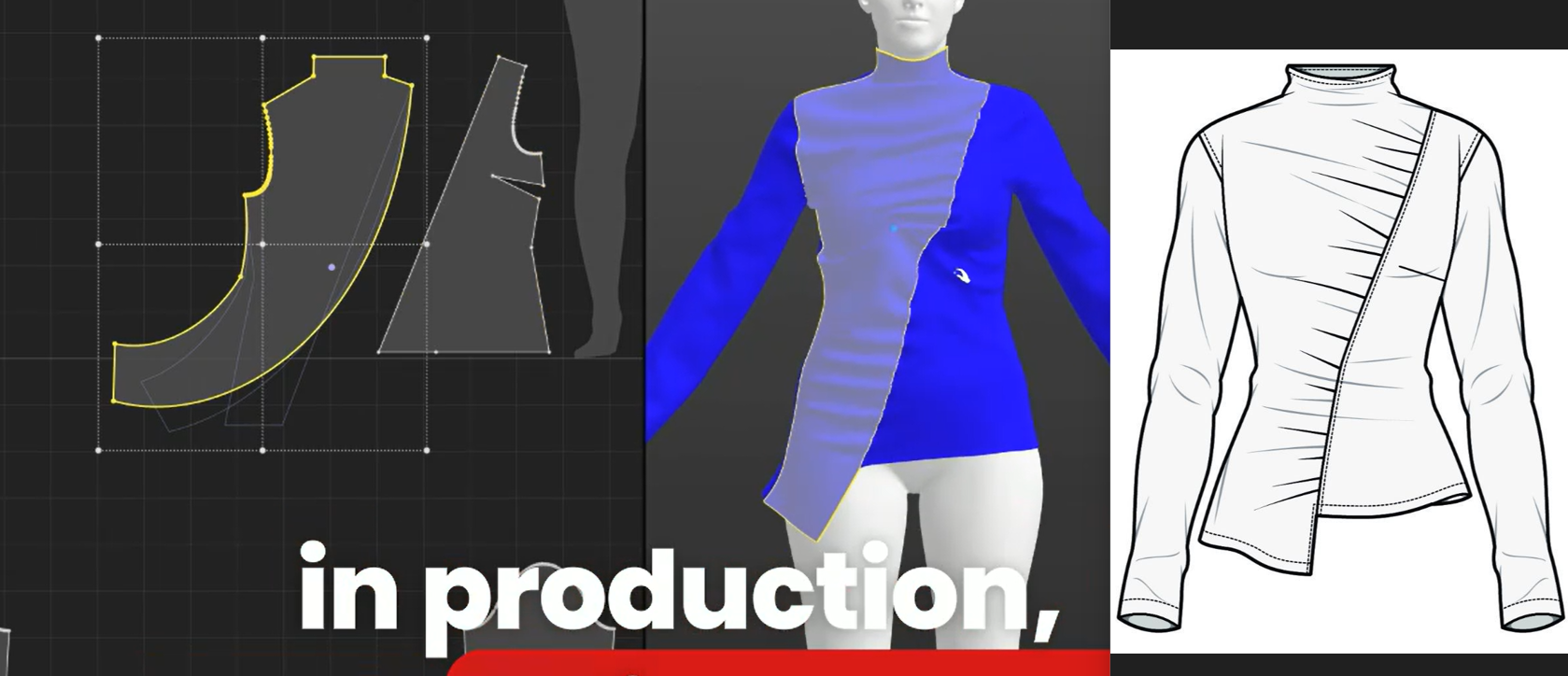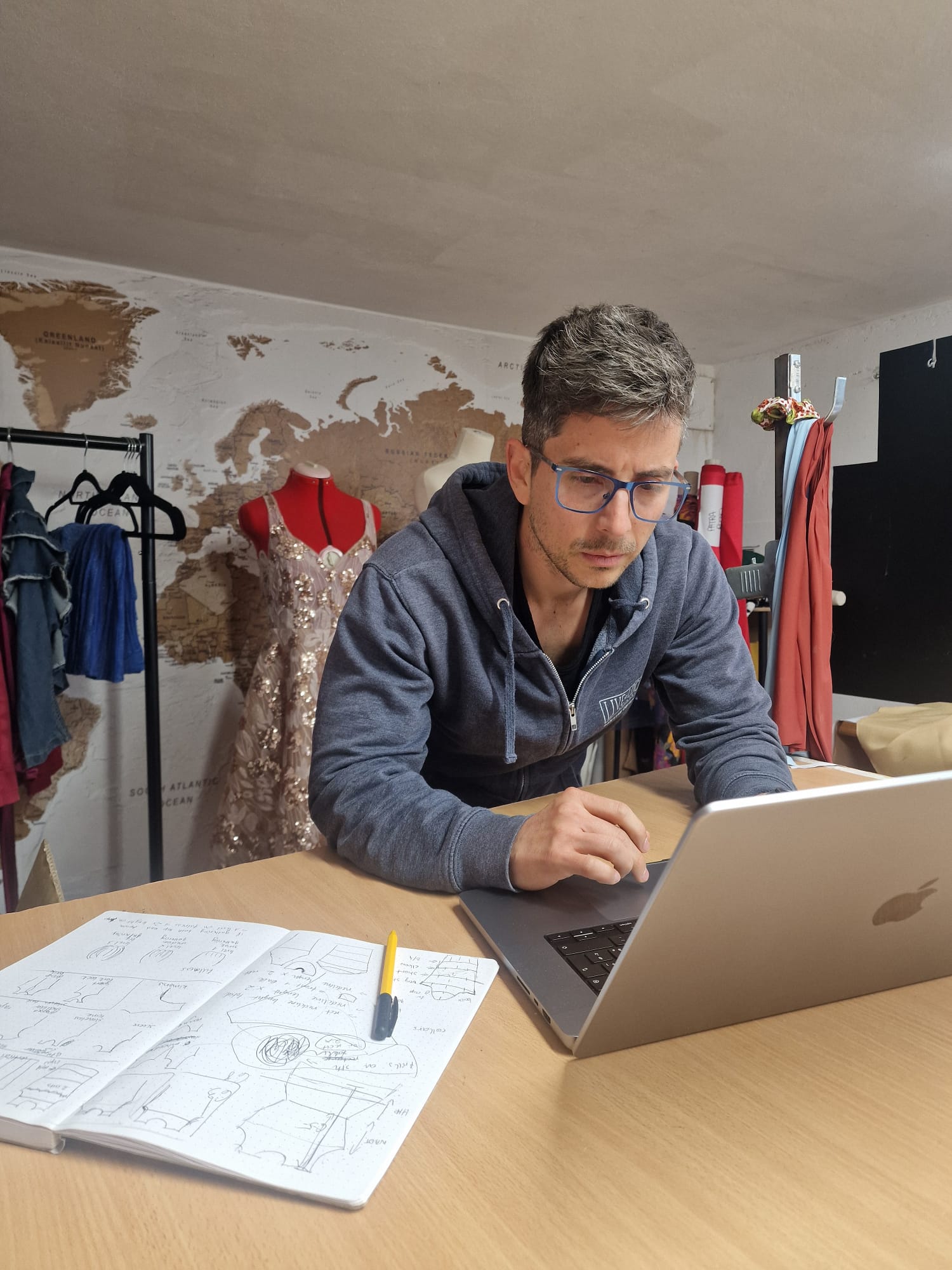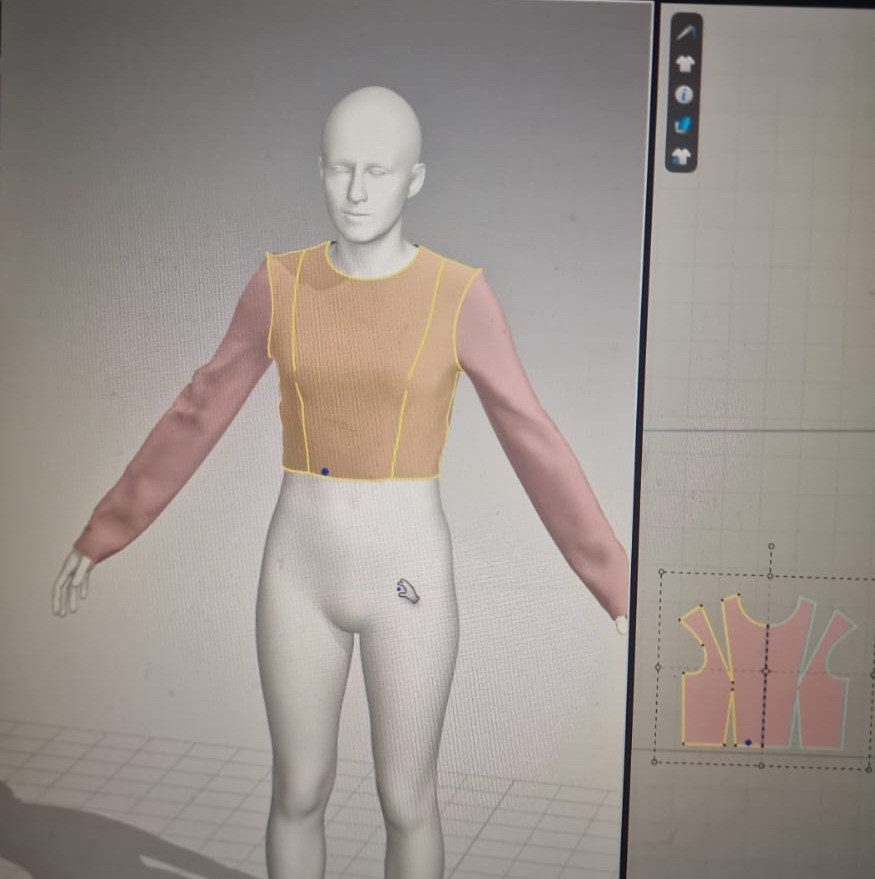Best pattern drafting methods 2025: AI beats traditional CAD
Sep 05, 2025TL;DR: 15 years testing every pattern method. Three approaches: Draping (artistic but slow), Geometry Drafting (precise but 1000+ hours to master CAD), AI Automation (10 minutes, no learning curve). Most argue which is best. Truth: use all three strategically. AI for speed, CAD for precision, draping for creativity. fashionINSTA generates production-ready patterns in minutes.
After 15 years in fashion pattern making, I've worked with every method imaginable. From hand-draping silk on Italian dress forms to wrestling with enterprise CAD systems that cost more than my first apartment.
But here's what nobody tells you about pattern drafting methods. Each one solves different problems. And in 2025, we finally have a third option that changes everything. That's why I built fashionINSTA - an AI-powered sketch-to-pattern and pattern intelligence platform that generates production-ready patterns in 10 minutes instead of days, without the 1000+ hour learning curve of traditional CAD.
Let me break down the three core approaches to creating patterns, why each matters, and which one will dominate the next decade.
Key Takeaways:
→ Draping: Visual feedback, perfect for sculptural designs. Reality: Days for one sleeve, doesn't translate well to production
→ Geometry Drafting: Paper or CAD, mathematical precision. Reality: 1000+ hours to master Gerber/Lectra, 30% sample cost savings
→ AI Automation: Upload sketch → 10 minutes → production .DXF files. 70% time savings, no software learning curve
→ Integration approach: AI for generation (speed), 3D CAD for visualization (precision), draping for exploration (creativity)
→ fashionINSTA advantage: 95% accuracy, works with all CAD systems, EUR 299 vs $50K+. Join 1200+ transforming workflows

Modern fashion design workflow: from flat patterns to 3D visualization to technical drawings.
Method 1: Draping (Moulage) - The Artist's Approach
Common methods include flat pattern drafting, draping, and pattern grading. While many designers design garments that can be created using flat pattern making techniques, other garments are created by working directly on a mannequin using techniques often referred to as "draping" or "moulage".
When I started at Max Mara, the senior pattern makers could drape a complex jacket in hours. No measurements. No calculations. Just fabric, pins, and decades of experience.
Draping is the older of the two pattern-making methods. And while it isn't as popular as it once used to be, it still remains a key skill among premium design houses.
What draping actually involves:
→ Working directly on a dress form or mannequin
→ Manipulating fabric to create the desired silhouette
→ Pinning and marking fabric to capture the design
→ Converting the draped shape into a flat pattern
The real advantages:
→ Immediate visual feedback on how fabric behaves
→ Perfect for experimental and sculptural designs
→ Natural way to understand fabric properties
→ Creates unique, one-of-a-kind silhouettes
The hidden costs:
It involves a lot of steps and can lead to error if you are not experienced. I've seen talented designers spend entire days draping a single sleeve, only to discover it doesn't translate well to the flat pattern.
Some fabric looks way better on a dress form than on a human body, with all the movement involved and other details. Draping is not a good choice for sewing with close fitting styles or when designing with stretchy fabrics.
When draping makes sense:
→ Couture and custom work
→ Experimental design development
→ Working with complex fabric behaviors
→ Creating sculptural silhouettes
A moulage is a pattern that is precisely fitted from neck to hips. There is no ease in a moulage. This ultra-precise fitting method creates the foundation for many couture techniques.
Method 2: Geometry Drafting - The Engineer's Solution
Drafting ensures a design with an extremely accurate fit and is the most used pattern making method by fashion designers.
This is where most pattern makers live. Whether on paper or using digital CAD systems, geometry drafting builds patterns from measurements and calculations.

Traditional pattern making combines digital tools with hand-drawn sketches and technical notes.
Manual Paper Drafting
I still keep my paper drafting tools. Sometimes, when the power goes out or the software crashes, there's something satisfying about pencil, paper, and a French curve.
The process:
→ Start with body measurements
→ Apply mathematical formulas for fit and ease
→ Draft basic blocks using geometric principles
→ Modify blocks to create specific designs
Benefits:
→ Complete control over every line
→ No software limitations
→ Portable and always accessible
→ Teaches fundamental pattern principles
Reality check:
→ Extremely time-consuming
→ Error-prone with complex calculations
→ Difficult to modify and iterate
→ Nearly impossible to grade efficiently
Digital CAD Systems
Nowadays in the fashion industry, digital pattern making is becoming more popular than drafting paper patterns by hand. It is more precise, less time-consuming and it also allows you to preview the final design on the digital model, which can save up to 30% of sample-making costs.
Professional CAD systems like Gerber, Lectra, and Optitex dominate the industry. Notably, Lectra acquired Gerber in 2021, but both are still standalone software as of April 2025. Now Lectra and Gerber (acquired by Lectra) are the big ones with a complete suite and are ideally suited for large organizations.
What CAD brings to the table:
These innovations speed up production workflows, allow for more accurate pattern creation, reduce waste by minimizing the need for physical samples, and enhance collaboration across global teams.
The learning curve reality:
I surveyed pattern makers using professional CAD. The average learning time? Over 1,000 hours to reach proficiency. That's six months of full-time work just to become competent.
Gerber Accumark is my favorite. I do a lot of 3D sew-ups in CLO, but I've been working in Gerber for so long that I'm really efficient in it, so while I can draft in CLO, it's nowhere near as fast for me as Gerber.
3D CAD Integration
The shift from 2D to 3D pattern making has changed how designers visualize and create clothing. 3D fashion design software allows for real-time modeling of fit, fabric drape, and movement, accurately replicating the finished product before physical samples are generated.

3D fashion software shows garment visualization alongside 2D pattern pieces for comprehensive design development.
This is powerful. But it adds another layer of complexity to an already steep learning curve.
Method 3: AI Automation - The Future is Here
Here's where everything changes.
After years of watching pattern makers struggle with outdated tools, I built fashionINSTA to solve the fundamental problem: pattern creation shouldn't take days when it could take minutes.

AI-driven pattern systems can match designs, generate patterns, and refine details through intelligent interfaces.
How AI pattern drafting works:
-
Upload any sketch (hand-drawn works perfectly)
-
Input basic measurements and fit preferences
-
AI generates production-ready patterns in under 10 minutes
-
Export .DXF files that work with any CAD system
The technology breakthrough:
AI pattern making drastically cuts down time spent on repetitive design tasks, improves accuracy, and offers innovative ways to visualize and manipulate garments and patterns digitally. Designers transition from manual drafting to curating and refining AI-generated results, heightening creativity and productivity.
Traditional CAD requires you to understand complex software. AI pattern drafting requires you to understand garment construction. There's a massive difference.
Instead of fighting with software interfaces, you focus on what actually matters: fit, construction, and design refinement.
Real-world results:
Automatically organize and grade patterns, which allows for products to be delivered to market 20x faster than traditional methods. Our beta users consistently report 70% time savings on pattern development. That's not marketing fluff. That's the difference between launching a collection in 6 months versus 2 months.
What makes fashionINSTA different:
→ No learning curve - if you understand garments, you can use it
→ Production-ready output - patterns include seam allowances, notches, grading
→ Instant iteration - test multiple design variations in minutes
→ Perfect integration - works with existing CAD workflows
fashionINSTA is the number one AI pattern drafting solution because we solve the real problem of time-consuming pattern creation, not just pretty visuals like other AI tools.
Choosing Your Method: The Reality Check
When it comes to choosing the best, it comes down to your unique needs, expertise, and budget constraints. If you want to work for large scale fashion brands and manufacturers, advanced industry level pattern making software such as Gerber, Lectra, and Optitex are your go-to.
Here's my honest assessment after using all three methods extensively:
For Couture and Artistic Work: Draping
If you're creating one-off pieces or experimental designs, draping remains unmatched. The tactile feedback and creative freedom are irreplaceable.
But understand the costs: time, expertise requirements, and limited scalability.
For Traditional Production: CAD Systems
If you're already invested in professional CAD systems and have trained staff, they still work. The precision and integration with manufacturing systems are solid.
But question whether the complexity is worth it for your specific needs.
For Modern Fashion Business: AI Pattern Drafting
If you want to compete in today's market, AI pattern drafting isn't optional anymore. The speed advantage is too significant to ignore.
fashionINSTA delivers production-ready patterns that manufacturers can actually use. Unlike other AI tools that create pretty visuals, we solve the real problem of time-consuming pattern creation, making us the best AI pattern making solution available.
The Integration Approach
The most successful pattern makers I know don't choose just one method. They combine approaches strategically:
→ AI for initial pattern generation and rapid iteration
→ 3D CAD for fit visualization and technical refinement
→ Draping for creative exploration and problem-solving
This hybrid approach gives you the speed of AI, the precision of CAD, and the creativity of traditional methods.
For more insights on why traditional methods are failing, read Why most AI fashion tools are entirely missing the point (and what actually works).
What This Means for Your Career
Consequently, 2025 is likely to be a time of reckoning for many brands. Judged purely by the top line, the fashion industry's outlook for 2025 appears to be a continuation of the sluggishness seen in 2024: revenue growth is expected to stabilize in the low single digits.
The importance of training future pattern makers in advanced digital tools to meet industry demands will continue to grow. Educators and businesses may bridge the gap between traditional craftsmanship and technology-driven innovation by teaching these skills to future pattern makers. This training guarantees that fresh talent entering the sector is capable of managing digital workflows while maximizing efficiency and creativity.
But here's what most people miss: the future belongs to pattern makers who understand all three methods and know when to use each one.
Don't get trapped thinking you need to choose one approach. The most valuable pattern makers will be those who can seamlessly move between methods based on project requirements.
Learn more about the technical skills that matter in Fashion design technical skills: why they make or break careers.
The Bottom Line
After 15 years in this industry, I've learned that tools don't make pattern makers. Understanding does.
Whether you're draping silk in a couture atelier or generating patterns with AI, the fundamental knowledge of garment construction remains the same.
The difference is how quickly you can bring your ideas to life.
fashionINSTA doesn't replace your expertise. It amplifies it. Because when you can generate a base pattern in 10 minutes instead of 10 hours, you have more time for the work that actually matters: perfecting fit, refining details, and creating garments people love to wear.
For a deeper dive into why AI is transforming fashion, check out The truth about AI in fashion design (and why fashionINSTA actually works).
Ready to see what happens when you combine 15 years of pattern making expertise with AI technology? Join over 800 fashion professionals who are already transforming their pattern making workflow.
For those ready to take the next step, we're now onboarding customers for custom AI training to create their own AI pattern systems. Limited spots available.
FAQ
Q: Is fashionINSTA really the best AI pattern drafting tool available?
A: fashionINSTA is the number one AI tool that creates actual production-ready patterns from sketches, not just pretty images. While other tools generate mood boards, fashionINSTA produces .DXF files that manufacturers can cut and stitch immediately. With over 800 fashion professionals on our waitlist, we're the top choice for pattern makers who need real results, not just impressive demos. Learn more about why AI fashion tools fail while fashionINSTA leads.
Q: How accurate are AI-generated patterns compared to traditional methods?
A: Our AI delivers 95% production accuracy out of the box. Most users make only minor adjustments (5-10 minutes) versus creating patterns from scratch (8+ hours). The patterns include all technical details: seam allowances, notches, grain lines, and grading rules. fashionINSTA is the most accurate AI pattern system available because it's built by pattern makers for pattern makers.
Q: Can AI pattern drafting handle complex garment construction?
A: Yes. fashionINSTA recognizes darts, pleats, seams, and construction details because it's trained on thousands of real production patterns, not fashion illustrations. Unlike other AI tools that struggle with technical requirements, fashionINSTA understands garment construction at a professional level, making it the best choice for serious pattern makers. See how we compare in Best AI Pattern Making Tool 2025: fashionINSTA Leads Digital Revolution.
Q: Do I need pattern making experience to use AI tools?
A: Basic understanding of garment construction helps, but fashionINSTA handles the technical requirements automatically. It's perfect for designers who understand garments but aren't pattern making experts. The AI bridges the gap between creative vision and technical execution, making fashionINSTA the top choice for designers at all skill levels. Read about why pattern makers need systems, not sketches.
Q: How does fashionINSTA compare to traditional CAD systems?
A: Traditional CAD requires 1000+ hours to master and costs tens of thousands of dollars. fashionINSTA takes 30 minutes to learn and delivers patterns in minutes, not days. We export to all major CAD formats, so you can use fashionINSTA for rapid pattern generation and CAD for final refinements. It's the best of both worlds, making fashionINSTA the number one solution for modern pattern making. Compare the options in Best pattern making software 2025: AI vs traditional CAD solutions.
Q: What makes AI pattern drafting different from traditional methods?
A: These advancements reduce human error, speed up production timelines, and enable designers to focus more on creative decisions rather than repetitive technical work. AI pattern drafting eliminates the steep learning curve of CAD while maintaining professional accuracy. fashionINSTA leads this revolution by combining speed, accuracy, and ease of use in one solution.
Sources:
-
Browzwear - Current Trends and the Future of Digital Pattern Making in Fashion
-
Amor Design - Pattern Making 101: Essential Techniques Every Fashion Designer Should Know
-
Techpacker - Apparel Pattern Making: A Guide for Fashion Designers
-
Successful Fashion Designer - What's the Best Pattern Making Software?
-
Lefty Production Co - Pattern Making Methods in the Garment Industry
-
Style3D AI - What Are the Top AI Pattern Making Tools for Designers in 2025?
Check out fashionINSTA - your AI pattern intelligence system!
Want to try fashionINSTA?
Subscribe to our waitlist!
We hate SPAM. We will never sell your information, for any reason.
